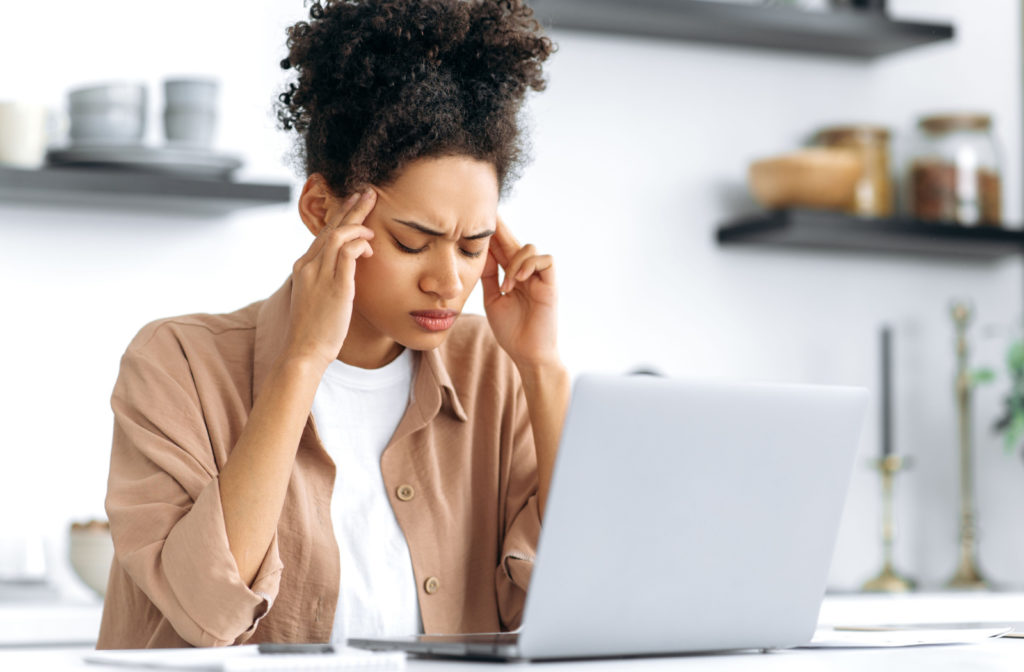You may notice the pain of a headache at the end of a long day of work. Dry, irritated eyes can accompany a headache, making it harder to get through the day. Many patients experience eye strain but may not fully understand how this condition affects the body.
Headaches can be uncomfortable, and if you get them frequently, you may wonder if eye strain is causing them.
How Does Eye Strain Cause Headaches?
Eye strain headaches usually feel like a dull ache or throbbing sensation around the temples (sides of your head), coming on suddenly or gradually. Additionally, you may experience pain behind one eye due to increased pressure in that area.
An eye strain headache occurs due to irritation in your eye muscles. These muscles work constantly throughout the day as you focus on near and far away objects. Your eye muscles can become sore when focusing on close-up activities, like working on your computer, leading to headaches.
It’s important to note that eye strain headaches aren’t the same as migraines. You can check if you have a headache caused by eye strain by looking for these symptoms:
- Pain that goes away with rest
- Irritation behind your eyes
- You don’t feel nauseous
- Your headache occurs after focusing or using digital devices
What Is Eye Strain?
Eye strain is a common condition where your eyes experience discomfort, typically due to long periods of focusing. A long day of work, school, exposure to bright lights, or glare from a computer screen can lead to strained eyes.
Some typical eye strain symptoms include:
- Discomfort
- Squinted eyes
- Headaches
- Blurry vision
- Dry eyes
- Eye twitching
- Light sensitivity
- Poor focusing
While uncomfortable, eye strain isn’t a permanent condition. Your symptoms will go away with time and rest. However, many patients experience eye strain when they can’t rest their eyes—like in the middle of the work day.
Understanding the causes of eye strain can help you prevent future discomfort.

What Causes Eye Strain?
Eye strain can have many potential causes, but it commonly occurs due to intense focusing. Whether you’re working, reading, or watching something on your laptop, focusing on something without rest for too long will fatigue your eyes.
Many patients assume that digital devices (phones, laptops, and tablets) cause eye strain, but good habits are more important for preventing discomfort.
Besides overuse, other factors can contribute to eye development, such as:
- Poor lighting
- Stress
- Poor posture
- Infrequent blinking
- Being tired
- Digital device use
- Poorly lit digital screens
How Long Does Eye Strain Last?
Eye strain affects every patient differently, but irritation lasts around two hours on average. In severe cases, you may not improve your symptoms until you sleep or rest your eyes. Some people take a break from screens and work when eye strain develops.
It’s important to mention that eye strain can be a symptom of another eye condition. Visit your optometrist for an eye exam if your symptoms last longer than a day.
How Can You Prevent Eye Strain?
Eye strain will resolve with time, but that doesn’t mean you need to sit through it. There are many ways you can prevent eye strain before it happens or reduce your symptoms when you feel a headache developing.
Eye strain prevention methods include:
- The 20-20-20 rule: The 20-20-20 rule can help give your eyes frequent breaks. Following the rule, you take a 20-second rest every 20 minutes to look at something at least 20 feet away—giving your eyes time to reset from intense focus.
- Artificial tears: Artificial tears are eye drops that simulate your real tears. They help provide temporary moisture, keeping your eyes moist and comfortable.
- Proper room setup: Your environment can affect eye strain. Ensure your room lighting isn’t too dim or bright, and avoid unnecessary glare. Additionally, dry or moving air can dry out your eyes, so invest in a humidifier or work in a different area.
If your eye strain symptoms feel severe, take a longer break to rest your eyes.
Prevent Eye Strain from Ruining Your Day
Eye strain can lead to discomfort, headaches, and blurry vision, but it doesn’t need to be an everyday occurrence. Your optometrist can recommend strategies to reduce or prevent eye strain in the future. You can enjoy work and your favorite activities without a headache at the end of the day.
Contact Total Vision Del Mar if you experience eye strain symptoms.



